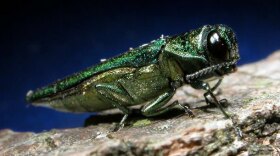The state department of agriculture has enacted an emergency quarantine to prevent untreated ash tree products and nursery stock from leaving Boulder County because of the Emerald Ash Borer.
The invasive insect was first discovered in Boulder in late September. It can infest an ash tree for up to four years before any visible signs are detected.
Kathleen Alexander is the Boulder city forester. She says they’ve already removed six trees.
“We know of another four in that same immediate area that are infested but are not yet showing symptoms. But the delimitation survey should help us determine how wide of an infestation area that we have,” she said.
Crews completed a visual assessment of all the ash trees within a half mile of the infestation. The delimitation survey involves removing and stripping small branches from healthy ash trees around Boulder to find out the full extent of the problem, which could take up to six weeks to complete.
“The Emerald Ash Borer is a highly destructive pest to ash trees. In other states, it has caused significant economic impact to property owners and the nursery and landscaping industries. The quarantine is vital to limiting further infestation,” said Colorado Department of Agriculture's Plant Inspection Division Director, Mitch Yergert.

The emergency quarantine prohibits the movement of all untreated plants and plant parts of the genus Fraxinus out of the quarantined area. This includes, but is not limited to:
- Logs and green lumber
- Nursery stock, scion wood, and bud wood
- Chips and mulch, either composted or uncomposted
- Stumps, roots and branches
- Firewood of any non-coniferous (hardwood) species
The Emerald Ash Borer is native to Asia. This is the first appearance of the insect in Colorado. It has killed over 50 million ash trees since its initial discovery in Michigan in 2002.
According to the Colorado Department of Agriculture, infestation signs include:
- Sparse leaves or branches in the upper part of the tree
- D-shaped exit holes about 1/8 inch wide
- New sprouts on the lower trunk or lower branches
- Vertical splits in the bark
- Winding S-shaped tunnels under the bark
- Increased woodpecker activity
http://youtu.be/9G-0eG632OI






